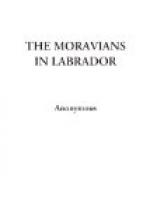Having concluded the solemn transactions of the day, the missionaries, towards evening, returned to the ship, and the next day the Esquimaux began to set out for their hunting stations. But Tuglavina and his wife remained some days longer to assist the brethren in seeking out an island, and then parted with tears on both sides. The missionaries rewarded them liberally for their services; and they were not forgetful of the favours they had now and formerly received. Mikak begged the brethren would take charge of two white fox skins for the Dowager Princess of Wales, of a black one for the Princess of Glocester, and two red ones for the Governor Palliser, as acknowledgments for their kindness.
The place pitched upon by the brethren for their settlement was 56 deg. 36 m. N.L., well supplied with good wood for building, and numerous rivulets of excellent water, and where ships could conveniently find an excellent anchorage. The stones they erected were placed, one on King’s point, marked G R III. 1770, the other marked U F (unitas fratrum,) 1770, and the land was taken possession of in the name of King George, for behoof of the United Brethren—a very important process, as it secured the protection of the British government for the new settlements; the other two stones were marked and placed in the interior merely as boundary stones. This first sacred spot was consecrated by thanksgiving and prayer. Amid the heathen tribes and their rude rocks, the missionaries kneeled down, and with the deepest expressions of humility, thanked the Lord that he had thus so far prospered them in their undertaking, had guarded them through the perils of their journey, and graciously granted them a resting place. Having thus accomplished the object of their mission, they returned to England, and reached London 16th November 1770, blessing and praising the Lord that no evil had befallen them.




